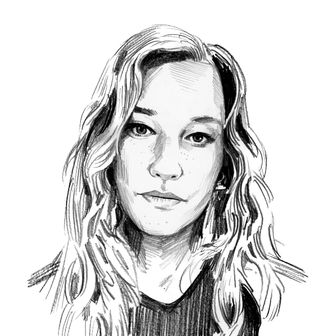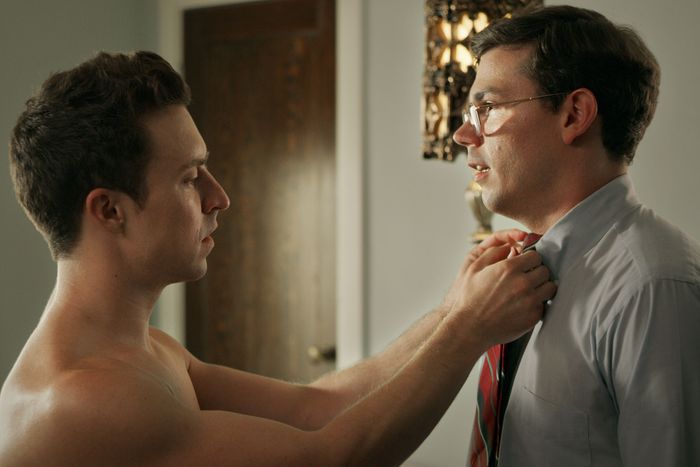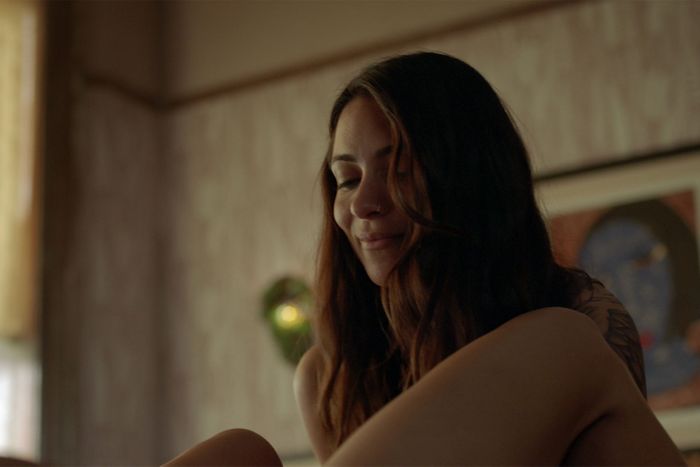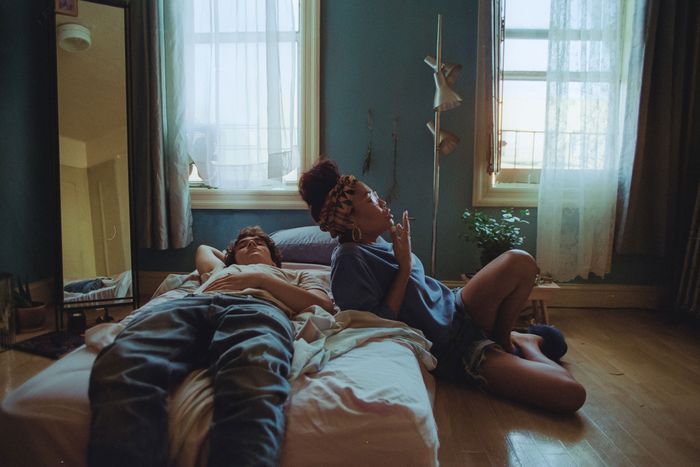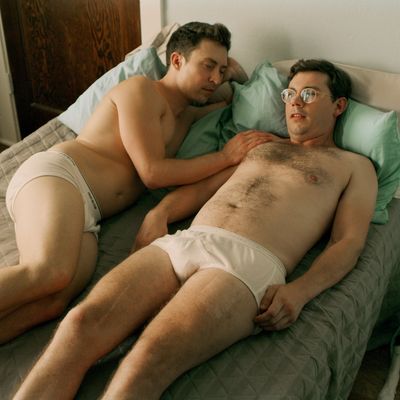
In 2013, Abdellatif Kechiche’s lesbian love story Blue Is the Warmest Color set Cannes aflame, in part thanks to an explicit, seven-minute sex scene. In it, the two leads, Léa Seydoux and Adèle Exarchopoulos, engage in an exhausting bout of scissoring, a lesbian sex act that primarily exists in the minds of men. The scene was immediately controversial, with critics like Manohla Dargis writing that “the movie feels far more about Mr. Kechiche’s desires than anything else.” Even Julie Maroh, the author of the novel the film was based on, weighed in, arguing that the scene was “a brutal and surgical display, exuberant and cold, of so-called lesbian sex.” She added, “This was what was missing on the set: lesbians.”
In 2018, Desiree Akhavan shot a very different lesbian sex scene. Her film, The Miseducation of Cameron Post, tells the story of a teen girl (Chloë Grace Moretz) sent to gay conversion camp after she’s caught sleeping with her female best friend. Early on in the film, Cameron and Coley tentatively make love for the first time in the back seat of a car. The sex is subtle and nuanced, the result of two young women clumsily figuring out how to please each other. The camera focuses on the girls’ nervous, thrilled faces, rather than panning breathlessly down their bodies. Akhavan told Vulture she asked the actresses to figure out the specifics of the scene on their own — in private. “There is no white male straight gaze in the film,” Moretz told Out. “It was really beautiful, because not only was our director female, but our cinematographer was female. And I think you can feel that in the scenes! There’s an intimacy and a sweetness to them. They’re not voyeuristic.”
Six years after the debut of Kechiche’s film, shows like Special, Pose, and Vida have made major strides in bringing authentic queer sensuality to TV. We’re still grappling with the Bohemian Rhapsodies of the movie world, but movies like Cameron Post, Port Authority, and Wild Nights with Emily are ensuring genuine portraits of intimacy are breaking through in film, too. In conversation with Vulture this month, the filmmakers and showrunners behind these projects expressed in no small terms that the process of getting queer sex onscreen hasn’t gotten any easier. But as more and more queer creators are being empowered to tell their own stories, onscreen depictions of LGBTQ intimacy have grown richer. Below, we ask Akhavan, Vida’s Tanya Saracho, Special’s Ryan O’Connell, Pose’s Steven Canals, Port Authority’s Danielle Lessovitz, and Wild Nights with Emily’s Madeleine Olnek to break down their best sex scenes and explain what makes each work:
Ryan O’Connell, creator and star of Special
The scene: In episode three, Ryan (Ryan O’Connell), a gay man with cerebral palsy, loses his virginity to a sex worker named Shea (Brian Jordan Alvarez). The scene begins with a suit-clad Ryan arriving at Shea’s apartment, follows him as he bashfully undresses and discusses his past sexual experiences (or lack thereof), and ends with Shea putting on a condom and the two having sex in the missionary position (while Shea’s dog watches).
It’s so funny — I’ve gotten so many questions about this scene, and when I wrote it, I didn’t know that I was writing a “gay scene,” like, capital G-A-Y. Because there wasn’t so much thought around it. Gay sex is really exciting as a creator because you’re just like, “Oh! There’s so much that hasn’t been explored.” Think about all the stupid straight sex we had to sit through our entire lives.
My first time was when I was 17, on my stomach, in my old childhood bedroom, but there were definitely bits of the scene that I took from my own sex life and my experience with sex workers. I also went to a sex worker whose dog wouldn’t get off the bed. I was like, “Okay. We are just sharing this room with your dog and loving life!” It is kind of autobiographical in that way.
My director Anna Dokoza and I talked a lot about the scene and what we wanted it to be. The filming itself was such a beautiful thing. Brian Jordan Alvarez is an amazing performer, and so generous. He’s like a unicorn. That scene was really overwhelming for me to film, because I’ve never acted before, and then here I am, doing an intense sex scene and hanging out with a cock sock on for the whole day! We didn’t really have time to rehearse it. I think that actually kinda helped. We definitely had a road map that we wanted to go off of, but we had to improvise some of it too, because it just took me forever to get out of that goddamn suit. But I truly think, watching it now, it plays like a documentary.
It’s a crown jewel of the show for me. The reception has been crazy fucking positive. I think that we’re really ready, as a culture, for the conversation about disabilities to begin. It is happening, but very slowly — and I think my show really was like, “Ok, we need to start examining disability.” Why are there only a few shows about disabled people for a population where one in four people identify as disabled? That’s insane to me. I’ve been really lucky that I’ve been surrounded by a big group of people who’ve helped me bring my vision to life. But don’t get it twisted: There is so much homophobia in Hollywood. I think I’m the exception to the rule.
Desiree Akhavan, writer and director of The Miseducation of Cameron Post
The scene: Early on in the film, Cameron (Chloë Grace Moretz) and Coley (Quinn Shephard), two women who’ve been hooking up in secret, are smoking pot in the back of their car on prom night before Coley whispers, “I want to try something.” Coley then tops Cameron, who climaxes just as her boyfriend opens the car door.
It’s super difficult to get two women onscreen together. Look at the MPAA: If you show a woman getting head, it’s automatically NC-17. Boys Don’t Cry was forced to recut its oral sex scenes because they were going to get a NC-17 rating, which would have kept them out of theaters. But think about how many times you’ve seen some girl on her knees sucking dick. Think about Jason Biggs fucking a pie! You grow up with this prescriptive idea: This is what penetration is, this is what sex is, this is what it should look like — the simultaneous orgasm.
The scene in the back of the car in Cameron Post was my first real triumph on that shoot. We shot it the first week, and most of what we shot that week didn’t end up in the film; it was a hard week. We had overwritten the script. But this scene was written really simply. I think the script was something like: “They’re in the backseat of the car and they’re having sex,” and something like, “Coley’s feeling it. Coley’s driving this in some way.”
I got this feeling that day that Chloë didn’t want to be backseat driven — that she had come prepared. I instantly told my AD, “I want everyone gone. I want only Ashley Connor, our DP, in the front seat with the camera.” I put Chloë and Quinn in a car nearby, and I said, “Rehearse the scene, go through the beats. I’m not going to watch it. I’ll watch the first take and if I want to redirect, I will, but otherwise I want to be surprised.” I hid everybody in the school, including myself. I remember my first AD said, “Okay … but that’s not what I would do.” But I remember thinking, “Just trust me.” I had a gut feeling that whatever I would see from the girls would be inspiring, whether or not we would use it. And they were both really eager and excited to do that.
The first take was perfect. That’s what you see onscreen. I remember at the monitor — and this doesn’t happen very often — we all collectively had chills. It’s rare and it’s special when that happens. What I love about shooting sex is that it’s a real opportunity to have a dialogue about something that people never talk about — particularly queer sex, because queer sex is so improvisational. There are no rules. You make it up as you go.
Steven Canals, co-creator, executive producer, and writer of Pose
The scene: In season one, episode three, Stan (Evan Peters), a cisgender man married to a cisgender woman, hands Angel (Indya Moore), a trans woman, the keys to her new apartment. The two then have sex for the first time, making out on Angel’s new bed, pulling off their clothes before Stan reaches into a drawer and puts on a condom. Before Stan enters Angel, the camera pans to the window.
A lot of trans women were worried that there was going to be violence toward Angel on Pose. Because that’s often what happens in real life, and what we see onscreen. But the Angel-and-Stan storyline was conceived as a love story. We knew that would be a first, because we really haven’t seen trans folks in loving relationships with cisgendered folks onscreen. My partner’s trans, and when we were crafting the Angel-Stan storyline, that was definitely at the forefront for me. I don’t want our love to be questioned. Our love is our love, and I don’t feel like I have to defend it. I want to normalize the experience of a cis person being with a trans person.
So in constructing this story and specifically this scene, we were very conscious and aware that this was a first. Obviously, there were a lot of complications that come along with Stan and Angel’s love, because he’s married and she’s a survival sex worker. We felt, as storytellers, an immense responsibility to make it as nuanced as possible. That’s the reason why you see Stan grab a condom, and put the condom on. We knew that we were sending a message out to our audience: safety matters and safety’s first. But we also wanted the scene to be loving, to show the connection between these two characters.
I think the choice about how graphic to be, or how much to show, really comes down to two things. One is the network that the show lives on, and the other is the tone of the show. Even though Pose airs on FX, we see Pose as a family drama. There are absolutely bold choices that we make on our show, but we also wanted to bring in a younger audience who may not know a whole lot about what it means to be trans and also black or Latin. And when it comes to any sex scene, everything has to be earned. Especially when one of the two individuals in this particular scene is trans and being played by a trans woman. There’s already so much focus on trans bodies. We were very aware of how we were portraying that moment, and how we were utilizing Indya as an actress. We didn’t want to expose her or her body simply for the sake of feeding into the curiosity of an uneducated audience member.
I’ve seen plenty of interviews with trans actresses and trans women in the media where they’re asked, “Have you had bottom surgery?” That’s really nobody’s business. We had a moment in the pilot where we acknowledge that Angel had not yet had bottom surgery, so we didn’t want to make a point of it again. And as a couple, Stan and Angel don’t have a hang-up at all about it. So if you as an individual still have a hang-up about it, then that’s on you. We just wanted it to feel like two people who are in love with one another and wanted to share their bodies with each other — and not have it feel voyeuristic. I’ve had trans women approach me, who haven’t had reassignment surgery, say, “It was really great to see a man love this woman, in her fullness.”
Tanya Saracho, showrunner of Vida
The scene: In season two, episode three, Emma (Mishel Prada) and Cruz (Maria-Elena Laas) are having sex at Cruz’s apartment. Cruz displays her veritable trophy case of sex toys, then selects a vibrator to pleasure Emma, covering it first with a condom. Emma is into it until she suddenly stops Cruz, laughing, and says, “I lost it!” Cruz puts the vibrator down and goes down on Emma until she climaxes.
This scene was a much-discussed moment in the room. The pitch that I had was, when you’re a single girl who’s sexually active, you might use a condom on a sex toy. It’s quicker, cleaner, and safer than cleaning your vibrators. But that caused a dilemma in the room! I have a lot of queer Latinas in the room, and all of them are in long-term relationships or married. So they were aghast. They were like, “Wait a minute! Are you with a new partner? You need to get a new vibrator!”
I even took it to my Facebook and I was like, “Hey, my queers, do you use a condom on your vibrator?” And a ton came back like, “Of course,” while others were like, “No, you just wash it.” But if you don’t wash it well enough, you could still get an infection, because it’s porous. It was a funny discussion for such a small moment. Someone at Planned Parenthood saw it at Tribeca and ran up to me, like, “Thank you for using a condom in a homosexual scene!” And I’m like, “Yeah, because I use a condom!”
For me, it was a way to scream louder than words about where Cruz was in her sexually active life — she’s playing the field. And it speaks to where they are as a couple, too, and about who Cruz is — she has all her toys out! It’s also the first time we see Emma being a little bit vulnerable. I love the part where Emma says, “I lost it.” Women know what that means, because coming is not always like, “Oh my God!” Usually, when women come onscreen, it’s so easy and fast. But here, it’s like, “Nope, even this amazing apparatus is not doing it.” At one point, Emma goes, “Too much, too much!” And women know what that means, too: Let it sit for a little. Maybe try another place. I wanted to show that it’s okay to give instructions to your lover. So with this tiny moment, we say so many things, and I love that.
For each sex scene on Vida, two days before, we’re required by Starz — which I love — to choreograph every single moment. Then we do a very thorough contract, where we all discuss the movements, the nudity, everything. The director, the cinematographer, the first AD, my producers, me, and the actors — we’re all in on that conversation. The actors know that they can change their minds, even when we’re shooting, and they need to know that. They’re safe and we can pivot. This scene was done in parts, because it was so technical. There was a cinematographer on the bed shooting, standing over the actors. The way we shot this particular scene, it makes you feel really inside their world. It might make you feel uncomfortable, which is by design — like, “Whoa, should I be watching this intimate moment?”
Madeleine Olnek, writer and director of Wild Nights with Emily
The scene: Teenage Emily Dickinson (Dana Melanie) and her friend Susan (Sasha Frolova) share their first kiss beneath a pair of gigantic hats, then bid Emily’s parents goodbye as they head off on a month-long trip. The minute they leave, the two girls begin kissing all over Emily’s house before heading upstairs, turning off the lights, and falling backward onto each other. They wake up surrounded by petticoats, with Emily’s poetry about Susan overlaid onto the scene.
I’ve been telling love stories between women for 30 years now, on stage and on film. To be someone who writes gay stories like I have for all these years meant that I was signing myself up for a second-tier career. In many ways, to make gay stories, you were ruining a lot of opportunities — so if you were going to do that, it had to be very important. I’ve spent a lot of time thinking about sex onscreen. With this film particularly, I’ve gotten some very interesting feedback from a couple people who were disappointed that there wasn’t more sex shown in the film. This one filmmaker said to me, “Can you call Molly [Shannon, who plays older Emily] and Susan back in, and do a shot where she’s going down on her? I want to see her go down on her.”
I’m really more interested in what happens to two people after they sleep together — that’s why sex is important to people. It’s how it changes you. Look, this was Emily Dickinson. She wrote poems. This is someone who works in metaphor — and that’s how film can work. She wrote, “I taste a liquor never brewed”; she didn’t write anything overtly sexual. What’s more interesting is the poetry that she made out of the sex that she had.
I’ve always said: My goal is always to make homoerotic entertainment for the whole family. My dream as a filmmaker would be to make a rated-G lesbian movie. I wish that I could have seen a movie like that when I was growing up. With films that don’t have gay characters, we’ve been able to see romances that have a whole arc, a whole range of things. We haven’t seen a cartoon feature film where a same-sex relationship happens. Kids, at a very young age, start projecting themselves into these narratives. You can know of the existence of gay people, but unless you’ve been really moved by a love story, you really don’t see how it applies to you.
Danielle Lessovitz, writer and director of Port Authority
The scene: Wye (Leyna Bloom), a transgender woman, and Paul (Fionn Whitehead), a cisgender man, are having sex for the first time in Wye’s bedroom. The two face each other in bed on their knees before Paul reaches down and touches Wye below the waist, making intense eye contact. Paul then enters Wye from behind before the camera cuts to a shot of Wye on top. The scene ends as both fall asleep.
In the script, the scene was an outline, a container to be filled. The scene really took form with Leyna, and I think that’s a testament to her. Throughout the whole project, I kept asking, “Is this something you would do in real life? Does this feel natural to you?” There were long conversations with Leyna about what position she feels most loved in, and she was really open to describing it all to me: “I like this position, I feel really good when he’s here and I’m here.”
I asked her about her personal experiences pre-transition, and she offered me this beautiful insight: There’s always a moment of acknowledging the body, and maybe the difference in the body. She visualized the moment where he places his hand on her genitals and just looks her in the eye, acknowledges and accepts her physically, and desires her. We felt it was really important to not acknowledge or answer where Wye was in her transition, because it’s private to the two of them. It’s not something we need to know in order to understand the emotional truth of the scene, and it’s not something we really need to know to understand his love for her or her love for him.
We were all … I don’t know if nervous is the right word, but giddy nervous, because it was such an intimate moment. We tried to keep things very professional, naming the body parts without assigning any kind of sensuality to them. I think it was important that it was a closed set — just the DP, myself, Leyna, and Fionn. We filmed a rehearsal, and both Leyna and Fionn watched that rehearsal and then consented, or not, to recreate it. Leyna then watched all three takes and she said which one she liked best, and that’s what we ended up using. The goal was not to represent all trans experiences — that’s impossible. But we wanted to represent one person’s experience, and potentially create a conversation about it.
Historically, queer sex scenes — let’s say between women, for example — have been created or crafted by men, and the gaze of that is going to feel very different. I don’t want to say that only those who know directly of an experience should be behind the camera, or should be directing those experiences; I don’t necessarily believe in that. I think the answer is more humility moving forward, and understanding that your idea of something might not connect to the actual experience of it. There’s always a lot of work to be done, but I think right now, we’re in a cool place where we’re becoming aware of what the blinds spots were, and we’re trying to navigate them in order to bring the full human experience into film.


